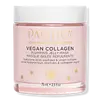What's inside
What's inside
 Key Ingredients
Key Ingredients

 Benefits
Benefits

 Concerns
Concerns

 Ingredients Side-by-side
Ingredients Side-by-side

Water
Skin ConditioningPentylene Glycol
Skin ConditioningDiglycerin
HumectantSpirulina Platensis Extract
Skin ProtectingPanthenol
Skin ConditioningFructooligosaccharides
HumectantCoconut Acid
CleansingBeta Vulgaris Root Extract
Skin ConditioningArginine
MaskingGlycogen
HumectantSalvia Hispanica Seed Extract
EmollientDipotassium Glycyrrhizate
HumectantPotassium Sorbate
PreservativeSodium Hyaluronate
HumectantCarrageenan
Lactobacillus Ferment
Skin ConditioningLeuconostoc/Radish Root Ferment Filtrate
AntimicrobialGlucomannan
Skin ConditioningLinolenic Acid
CleansingWater, Pentylene Glycol, Diglycerin, Spirulina Platensis Extract, Panthenol, Fructooligosaccharides, Coconut Acid, Beta Vulgaris Root Extract, Arginine, Glycogen, Salvia Hispanica Seed Extract, Dipotassium Glycyrrhizate, Potassium Sorbate, Sodium Hyaluronate, Carrageenan, Lactobacillus Ferment, Leuconostoc/Radish Root Ferment Filtrate, Glucomannan, Linolenic Acid
Water
Skin ConditioningGlycerin
HumectantHelianthus Annuus Seed Oil
EmollientIsopropyl Myristate
EmollientHydroxypropyl Starch Phosphate
Glyceryl Stearate
EmollientCetyl Alcohol
EmollientStearic Acid
CleansingGlyceryl Laurate
EmollientSr-Hydrozoan Polypeptide-1
HumectantGlyceryl Stearate Citrate
EmollientTocopheryl Acetate
AntioxidantSqualane
EmollientParfum
MaskingAllantoin
Skin ConditioningPanthenol
Skin ConditioningEthylhexylglycerin
Skin ConditioningLycium Barbarum Fruit Extract
AstringentHyaluronic Acid
HumectantPhenoxyethanol
PreservativeChamomilla Recutita Flower Extract
MaskingJasminum Officinale Extract
MaskingHibiscus Sabdariffa Flower Extract
Skin ConditioningCitrus Aurantium Amara Flower Oil
MaskingWater, Glycerin, Helianthus Annuus Seed Oil, Isopropyl Myristate, Hydroxypropyl Starch Phosphate, Glyceryl Stearate, Cetyl Alcohol, Stearic Acid, Glyceryl Laurate, Sr-Hydrozoan Polypeptide-1, Glyceryl Stearate Citrate, Tocopheryl Acetate, Squalane, Parfum, Allantoin, Panthenol, Ethylhexylglycerin, Lycium Barbarum Fruit Extract, Hyaluronic Acid, Phenoxyethanol, Chamomilla Recutita Flower Extract, Jasminum Officinale Extract, Hibiscus Sabdariffa Flower Extract, Citrus Aurantium Amara Flower Oil
Alternatives
Ingredients Explained
These ingredients are found in both products.
Ingredients higher up in an ingredient list are typically present in a larger amount.
Panthenol is a common ingredient that helps hydrate and soothe the skin. It is found naturally in our skin and hair.
There are two forms of panthenol: D and L.
D-panthenol is also known as dexpanthenol. Most cosmetics use dexpanthenol or a mixture of D and L-panthenol.
Panthenol is famous due to its ability to go deeper into the skin's layers. Using this ingredient has numerous pros (and no cons):
Like hyaluronic acid, panthenol is a humectant. Humectants are able to bind and hold large amounts of water to keep skin hydrated.
This ingredient works well for wound healing. It works by increasing tissue in the wound and helps close open wounds.
Once oxidized, panthenol converts to pantothenic acid. Panthothenic acid is found in all living cells.
This ingredient is also referred to as pro-vitamin B5.
Learn more about PanthenolWater. It's the most common cosmetic ingredient of all. You'll usually see it at the top of ingredient lists, meaning that it makes up the largest part of the product.
So why is it so popular? Water most often acts as a solvent - this means that it helps dissolve other ingredients into the formulation.
You'll also recognize water as that liquid we all need to stay alive. If you see this, drink a glass of water. Stay hydrated!
Learn more about Water